I’m currently working on a small scale solar home project, with the intention to provide autonomous power supply for phone and occasional laptop charging. The system is based on a 12V Lead-acid battery, and the easiest way to add chargers is to use car cigarette lighter accessories. The issue with those accessories though is that provided specs are often very limited. What interests me the most is standby current and efficiency, but I have never seen these provided in documentation for any cigarette lighter accessory.
Standby current and efficiency are important in estimating how fast battery is going to be drained. Standby current shows consumption of charger itself, when nothing is charging from it. Efficiency shows how much energy is lost during charging.
I got Satechi 72W USB-C and Anker Power Drive 2, and I have, of course, made some measurements.The Satechi charger has one USB-C and one USB-A port. The USB-C port supports 60W Power Delivery, and the USB-A port provides up to 2.4A. The Anker charger has two USB-A ports, with each providing 2.4 A.
To measure the efficiency I have used my Pixel 3 XL phone and XPS 9570 laptop as a load. The CPU-Z utility was very handy to put a 100% load on my laptop’s CPU to make it consume more than 60W. Photos of my test setup and plotted measurements are shown down below. To answer the question, it will take about three months for the Satechi charger to drain an average car battery, while being in standby. The Anker charger will drain you battery in about eight months. The efficiency of both chargers is in the range of 77% to 87%, depending on the conditions.
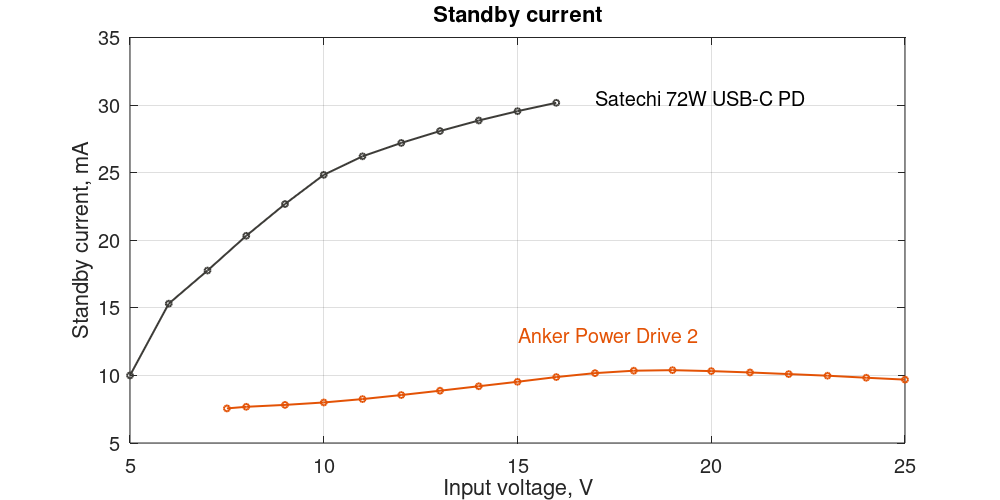
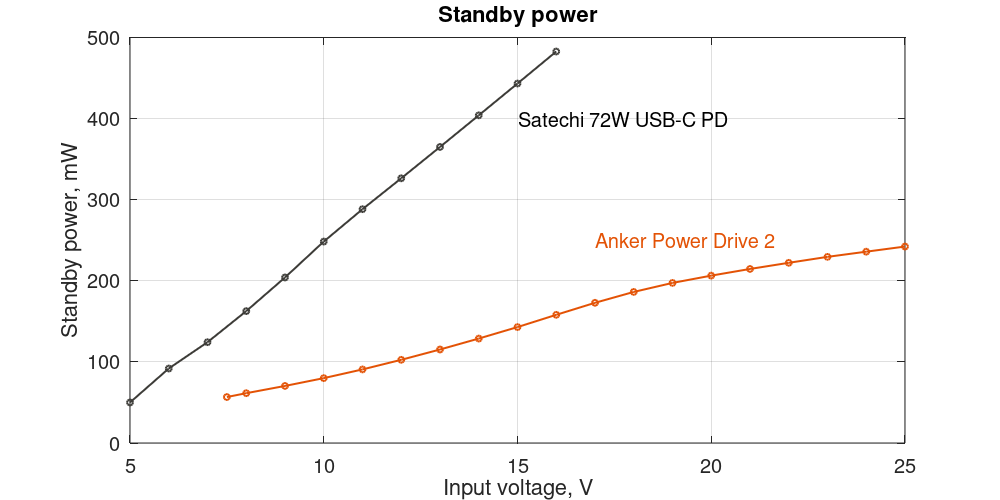



Octave/Matlab source code
This is the measurement data and source code for plotting the graphs in GNU Octave or MATLAB.
# Standby current Anker
# Turn off 7.1V, turns on 7.5V
# Voltage,V Current, mA
STB_ANKER = [7.50 7.56;
8.00 7.68;
9.00 7.82;
10.00 8.00;
11.00 8.25;
12.00 8.55;
13.00 8.87;
14.00 9.20;
15.00 9.53;
16.00 9.88;
17.00 10.17;
18.00 10.35;
19.00 10.39;
20.00 10.32;
21.00 10.22;
22.00 10.10;
23.00 9.98;
24.00 9.83;
25.00 9.69 ];
# Standby current Satechi
# Voltage, V Current, mA
STB_SATECHI = [5.00 10.00;
6.00 15.31;
7.00 17.76;
8.00 20.33;
9.00 22.68;
10.00 24.84;
11.00 26.21;
12.00 27.20;
13.00 28.08;
14.00 28.86;
15.00 29.55;
16.00 30.17];
figure(1)
plot(STB_ANKER(:,1),STB_ANKER(:,2), '-o', 'color', [227/255 82/255 5/255], 'LineWidth', 2);
hold on;
plot(STB_SATECHI(:,1), STB_SATECHI(:,2), '-o','color', [61/255 60/255 56/255], 'LineWidth', 2);
hold off;
grid on;
set(gca,'fontsize',20);
xlabel("Input voltage, V");
ylabel("Standby current, mA");
h = text (15, 13, "Anker Power Drive 2");
set (h, "fontsize", 20);
set (h, "color", [227/255 82/255 5/255]);
h = text (17, 30.5, "Satechi 72W USB-C PD");
set (h, "fontsize", 20);
title ('Standby current');
print('anker_satechi_standby_current.png', '-dpng', '-S1000,500');
figure(2)
plot(STB_ANKER(:,1),STB_ANKER(:,2).*STB_ANKER(:,1), '-o', 'color', [227/255 82/255 5/255], 'LineWidth', 2);
hold on;
plot(STB_SATECHI(:,1), STB_SATECHI(:,2).*STB_SATECHI(:,1), '-o','color', [61/255 60/255 56/255], 'LineWidth', 2);
hold off;
grid on;
set(gca,'fontsize',20);
xlabel("Input voltage, V");
ylabel("Standby power, mW");
h = text (17, 250, "Anker Power Drive 2");
set (h, "fontsize", 20);
set (h, "color", [227/255 82/255 5/255]);
h = text (15, 400, "Satechi 72W USB-C PD");
set (h, "fontsize", 20);
title ('Standby power');
print('anker_satechi_standby_power.png', '-dpng', '-S1000,500');
STB_DAYS = linspace(0, 7, 8).';
figure(3)
plot(STB_DAYS, STB_DAYS.*12*8.55*(24/1000), '-', 'color', [227/255 82/255 5/255], 'LineWidth', 2);
hold on;
plot(STB_DAYS, STB_DAYS.*27.20*12*(24/1000), '-','color', [61/255 60/255 56/255], 'LineWidth', 2);
hold off;
grid on;
set(gca,'fontsize',20);
xlabel("Days");
ylabel("Standby energy, Wh");
h = text (4, 5, "Anker Power Drive 2");
set (h, "fontsize", 20);
set (h, "color", [227/255 82/255 5/255]);
h = text (3.2, 21, "Satechi 72W USB-C PD");
set (h, "fontsize", 20);
title ('Estimated consumed energy during continious standby');
print('anker_satechi_standby_energy.png', '-dpng', '-S1000,500');
#Efficiency Satechi USB-C, laptop as a load, in BIOS
#Input voltage,V Input current, A Output Voltage, V Output Current, A
EFF_SATECHI_1 = [9.00 3.458 19.9 1.28;
10.00 3.057 19.9 1.28;
11.00 2.741 19.9 1.28;
12.00 2.487 19.9 1.28;
13.00 2.278 19.9 1.28;
14.00 2.112 19.9 1.27;
15.00 2.088 19.9 1.37;
16.00 1.952 19.9 1.38];
#Efficiency Satechi USB-C, laptop as a load, full cpu load
#Input voltage,V Input current, A Output Voltage, V Output Current, A
EFF_SATECHI_2 = [14.00 4.755 19.9 2.88;
15.00 4.408 19.8 2.89;
16.00 4.105 19.9 2.89];
#Efficiency Satechi USB-C, phone as load
#Input voltage,V Input current, A Output Voltage, V Output Current, A
EFF_SATECHI_3 = [4.00 2.72 9.03 0.89 ;
5.00 1.94 9.04 0.87;
6.00 1.530 9.06 0.83;
7.00 1.43 9.03 0.94;
8.00 1.18 9.01 0.90;
9.00 1.038 9.02 0.90;
10.00 0.930 9.04 0.89;
11.00 0.853 9.01 0.89;
12.00 0.784 9.04 0.89;
13.00 0.726 9.01 0.89;
14.00 0.678 9.00 0.90;
15.00 0.636 9.03 0.89;
16.00 0.599 9.02 0.90];
figure(4)
plot(EFF_SATECHI_1(:,1), (EFF_SATECHI_1(:,3).*EFF_SATECHI_1(:,4))./(EFF_SATECHI_1(:,1).*EFF_SATECHI_1(:,2)).*100, '-o', 'color', [227/255 82/255 5/255], 'LineWidth', 2);
hold on;
plot(EFF_SATECHI_2(:,1), (EFF_SATECHI_2(:,3).*EFF_SATECHI_2(:,4))./(EFF_SATECHI_2(:,1).*EFF_SATECHI_2(:,2)).*100, '-o', 'color', [61/255 60/255 56/255], 'LineWidth', 2);
plot(EFF_SATECHI_3(:,1), (EFF_SATECHI_3(:,3).*EFF_SATECHI_3(:,4))./(EFF_SATECHI_3(:,1).*EFF_SATECHI_3(:,2)).*100, '-o', 'color', [63/255 171/255 92/255], 'LineWidth', 2);
hold off;
grid on;
set(gca,'fontsize',20);
xlabel("Input voltage, V");
ylabel("Efficiency, %");
h = text (13.5, 88.1, "P_{out}=60W\nV_{out}=20V");
set (h, "fontsize", 20);
set (h, "color", [61/255 60/255 56/255]);
h = text (9.2, 80.1, "P_{out}=25W\nV_{out}=20V");
set (h, "fontsize", 20);
set (h, "color", [227/255 82/255 5/255]);
h = text (6, 79.9, "P_{out}=8W\nV_{out}=9V");
set (h, "fontsize", 20);
set (h, "color", [63/255 171/255 92/255]);
title ('Satechi 72W USB-C PD efficiency at different loads for USB-C port')
print('satechi_usb-c_efficiency.png', '-dpng', '-S1000,500');
#Efficiency Satechi USB-A, phone as load
#Input voltage,V Input current, A Output Voltage, V Output Current, A
EFF_SATECHI_4=[
5.0 0.631 4.36 0.61;
6.0 0.577 4.83 0.60;
7.0 0.495 4.83 0.60;
8.0 0.436 4.83 0.60;
9.0 0.391 4.83 0.60;
10.0 0.355 4.84 0.60;
11.0 0.327 4.82 0.61;
12.0 0.302 4.83 0.61;
13.0 0.282 4.83 0.60;
14.0 0.264 4.83 0.60;
15.0 0.249 4.82 0.60;
16.0 0.236 4.82 0.61];
#Efficiency Anker USB-A, phone as load
#Input voltage,V Input current, A Output Voltage, V Output Current, A
EFF_ANKER = [7.5 1.048 4.70 1.41;
8.0 0.980 4.71 1.41;
9.0 0.869 4.70 1.41;
10.0 0.783 4.7 1.41;
11.0 0.712 4.73 1.42;
12.0 0.654 4.74 1.41;
13.0 0.605 4.71 1.42;
14.0 0.563 4.72 1.41;
15.0 0.527 4.73 1.41;
16.0 0.496 4.74 1.40;
17.0 0.468 4.75 1.41;
18.0 0.443 4.75 1.41;
19.0 0.422 4.74 1.41;
20.0 0.402 4.74 1.41;
21.0 0.384 4.73 1.41;
22.0 0.369 4.74 1.41;
23.0 0.354 4.75 1.41;
24.0 0.338 4.76 1.41;
25.0 0.320 4.75 1.37];
figure(5)
plot(EFF_SATECHI_4(:,1), (EFF_SATECHI_4(:,3).*EFF_SATECHI_4(:,4))./(EFF_SATECHI_4(:,1).*EFF_SATECHI_4(:,2)).*100, '-o', 'color', [61/255 60/255 56/255], 'LineWidth', 2);
hold on;
plot(EFF_ANKER(:,1), (EFF_ANKER(:,3).*EFF_ANKER(:,4))./(EFF_ANKER(:,1).*EFF_ANKER(:,2)).*100, '-o', 'color', [227/255 82/255 5/255], 'LineWidth', 2);
hold off;
grid on;
set(gca,'fontsize',20);
xlabel("Input voltage, V");
ylabel("Efficiency, %");
h = text (20, 81, "Anker Power Drive 2\nP_{out}=6.64W");
set (h, "fontsize", 20);
set (h, "color", [227/255 82/255 5/255]);
h = text (16.5, 78, "Satechi 72W USB-C PD\nP_{out}=2.90W");
set (h, "fontsize", 20);
title ('Efficiency for USB-A ports')
print('satechi_anker_efficiency.png', '-dpng', '-S1000,500');

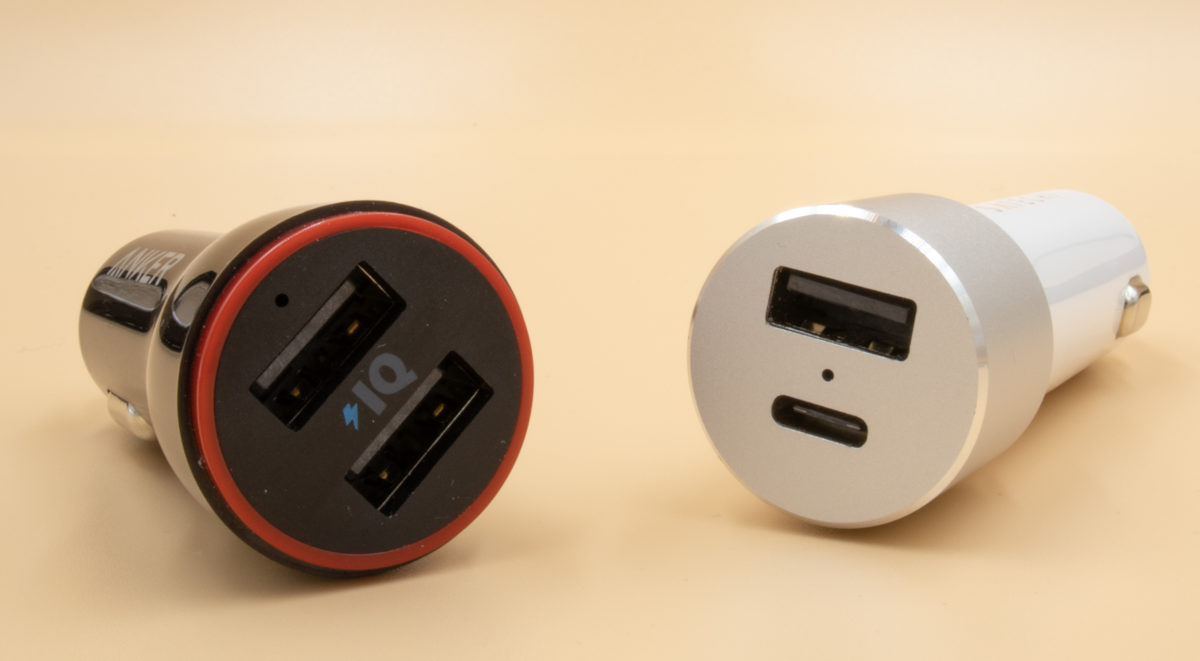
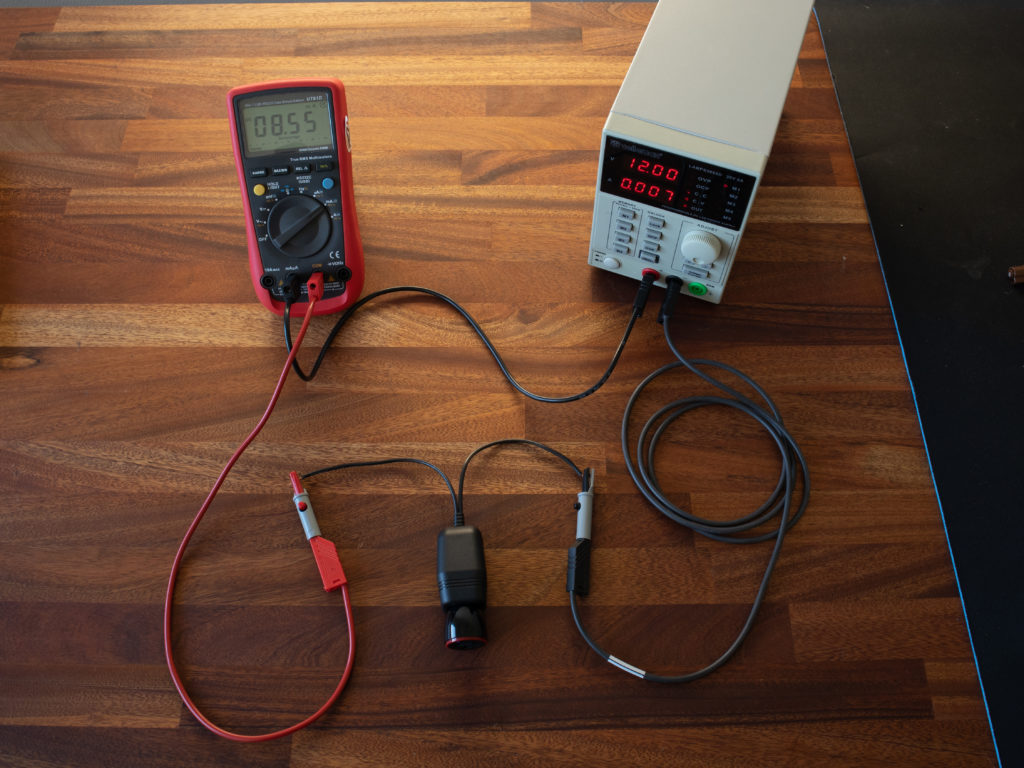


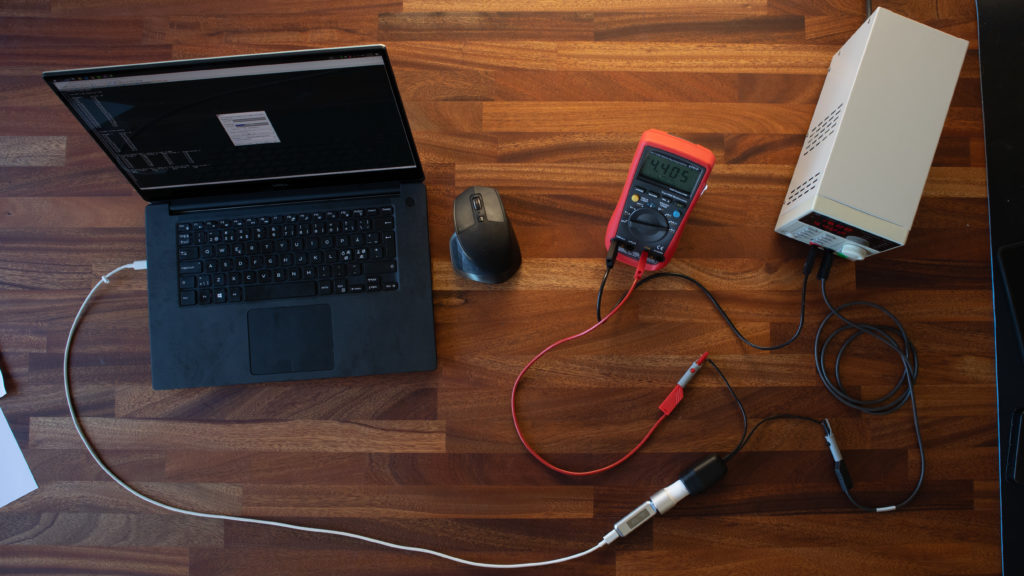

Well written article. It was an interesting read. You need a power supply with more than 5 A of output current.
Keep up the amazing work!